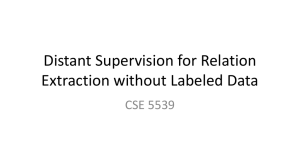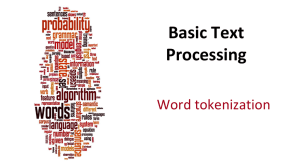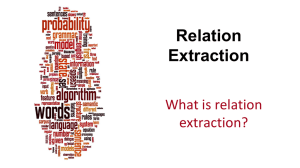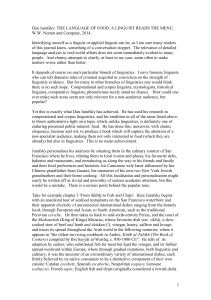Information Extraction
advertisement
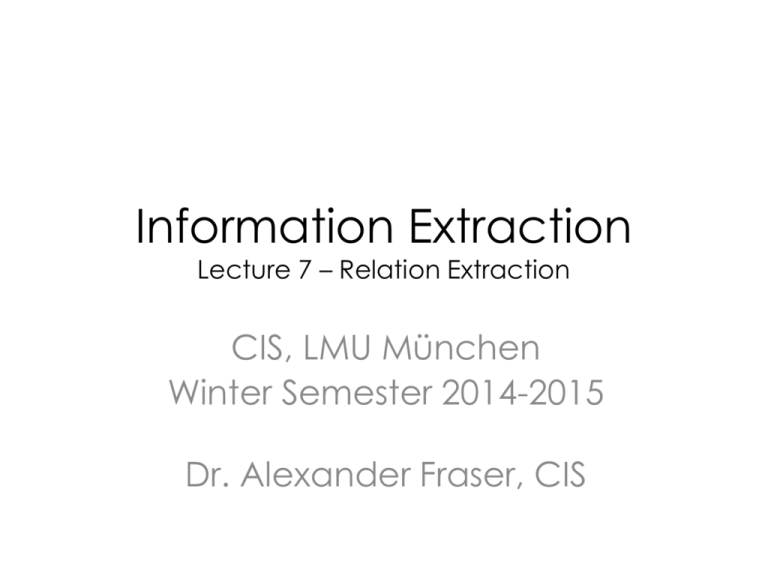
Information Extraction
Lecture 7 – Relation Extraction
CIS, LMU München
Winter Semester 2014-2015
Dr. Alexander Fraser, CIS
Relation Extraction
• Up until now we have focused on early
stages of the Information Extraction
pipeline
• We have emphasized named entity
tagging
• Now we will discuss extracting facts
about these entities
• This can include IS-A facts (similar to
named entity types), but also more
complicated relations
2
Extracting relations from text
• Company report: “International Business Machines Corporation (IBM or
the company) was incorporated in the State of New York on June 16, 1911, as
the Computing-Tabulating-Recording Co. (C-T-R)…”
• Extracted Complex Relation:
Company-Founding
Company
Location
Date
Original-Name
IBM
New York
June 16, 1911
Computing-Tabulating-Recording Co.
• But we will focus on the simpler task of extracting relation triples
Founding-year(IBM, 1911)
Founding-location(IBM, New York)
Slide from D. Jurafsky
Extracting Relation Triples from Text
The Leland Stanford Junior University,
commonly referred to as Stanford
University or Stanford, is an American
private research university located in
Stanford, California … near Palo Alto,
California… Leland Stanford…founded
the university in 1891
Stanford
Stanford
Stanford
Stanford
Stanford
Stanford
EQ Leland Stanford Junior University
LOC-IN California
IS-A research university
LOC-NEAR Palo Alto
FOUNDED-IN 1891
FOUNDER Leland Stanford
Slide from D. Jurafsky
Automated Content Extraction (ACE)
17 relations from 2008 “Relation Extraction Task”
PERSONSOCIAL
Family
PHYSICAL
Lasting
Personal
Near
Located
Business
GENERAL
AFFILIATION
CitizenResidentEthnicityReligion
ORG
AFFILIATION
Subsidiary
Geographical
Org-LocationOrigin
ARTIFACT
Investor
Founder
Ownership
PARTWHOLE
Student-Alum
Employment
Membership
Sports-Affiliation
User-Owner-InventorManufacturer
Slide from D. Jurafsky
Automated Content Extraction (ACE)
• Physical-Located
PER-GPE
He was in Tennessee
• Part-Whole-Subsidiary ORG-ORG
XYZ, the parent company of ABC
• Person-Social-Family
PER-PER
John’s wife Yoko
• Org-AFF-Founder
PER-ORG
Steve Jobs, co-founder of Apple…
•
6
Slide from D. Jurafsky
UMLS: Unified Medical Language System
• 134 entity types, 54 relations
Injury
Bodily Location
Anatomical Structure
Pharmacologic Substance
Pharmacologic Substance
disrupts
location-of
part-of
causes
treats
Physiological Function
Biologic Function
Organism
Pathological Function
Pathologic Function
Slide from D. Jurafsky
Extracting UMLS relations from a sentence
Doppler echocardiography can be used to
diagnose left anterior descending artery
stenosis in patients with type 2 diabetes
Echocardiography, Doppler DIAGNOSES Acquired stenosis
8
Slide from D. Jurafsky
Databases of Wikipedia Relations
Wikipedia Infobox Relations extracted from Infobox
Stanford state California
Stanford motto “Die Luft der Freiheit weht”
…
9
Slide from D. Jurafsky
Ontological relations
Examples from the WordNet Thesaurus
• IS-A (hypernym): subsumption between classes
• Giraffe IS-A ruminant IS-A ungulate IS-A
mammal IS-A vertebrate IS-A animal…
• Instance-of: relation between individual and class
• San Francisco instance-of city
Slide from D. Jurafsky
Patterns for Relation Extraction
• Hand-written rules for relation extraction were
used in MUC (such as the Fastus system)
• Recently there has been a renewed wide
interest in learning rules for relation extraction
focused on precision
• The presumption is that interesting information
occurs many times on the web, with different
contexts
• e.g., how many times does "Barack Obama is the 44th
President of the United States" occur on the web?
• Focusing on high precision is reasonable
because the high redundancy will allow us to
deal with recall
12
Rules for extracting IS-A relation
Early intuition from Hearst (1992)
• “Agar
is a substance prepared from a mixture of
red algae, such as Gelidium, for laboratory or
industrial use”
• What does Gelidium mean?
• How do you know?`
Slide from D. Jurafsky
Rules for extracting IS-A relation
Early intuition from Hearst (1992)
• “Agar
is a substance prepared from a mixture of
red algae, such as Gelidium, for laboratory or
industrial use”
• What does Gelidium mean?
• How do you know?`
Slide from D. Jurafsky
Hearst’s Patterns for extracting IS-A relations
(Hearst, 1992): Automatic Acquisition of Hyponyms
“Y such as X ((, X)* (, and|or) X)”
“such Y as X”
“X or other Y”
“X and other Y”
“Y including X”
“Y, especially X”
Slide from D. Jurafsky
Hearst’s Patterns for extracting IS-A relations
Hearst pattern
Example occurrences
X and other Y
...temples, treasuries, and other important civic
buildings.
Bruises, wounds, broken bones or other
injuries...
The bow lute, such as the Bambara ndang...
X or other Y
Y such as X
Such Y as X
Y including X
Y , especially X
...such authors as Herrick, Goldsmith, and
Shakespeare.
...common-law countries, including Canada and
England...
European countries, especially France, England,
and Spain...
Slide from D. Jurafsky
Extracting Richer Relations Using Rules
• Intuition: relations often hold between specific entities
• located-in (ORGANIZATION, LOCATION)
• founded (PERSON, ORGANIZATION)
• cures (DRUG, DISEASE)
• Start with Named Entity tags to help extract relation!
Slide from D. Jurafsky
Named Entities aren’t quite enough.
Which relations hold between 2 entities?
Cure?
Prevent?
Drug
Cause?
Disease
Slide from D. Jurafsky
What relations hold between 2 entities?
Founder?
Investor?
Member?
PERSON
Employee?
ORGANIZATION
President?
Slide from D. Jurafsky
Extracting Richer Relations Using Rules and
Named Entities
Who holds what office in what organization?
PERSON, POSITION of ORG
• George Marshall, Secretary of State of the United States
PERSON(named|appointed|chose|etc.) PERSON Prep? POSITION
• Truman appointed Marshall Secretary of State
PERSON [be]? (named|appointed|etc.) Prep? ORG POSITION
• George Marshall was named US Secretary of State
Slide from D. Jurafsky
Hand-built patterns for relations
• Plus:
• Human patterns tend to be high-precision
• Can be tailored to specific domains
• Minus
• Human patterns are often low-recall
• A lot of work to think of all possible patterns!
• Don’t want to have to do this for every relation!
• We’d like better accuracy
Slide from D. Jurafsky
Supervised Methods
• For named entity tagging, statistical
taggers are the state of the art
• However, for relation extraction, this is not
necessarily true
• Still many hand-crafted rule-based systems
out there that work well
• But hand-crafting such systems takes a lot of
work, so classification approaches are very
interesting (and they are improving with time)
• I'll now discuss how to formulate relation
extraction as a supervised classification
problem
23
Supervised machine learning for relations
• Choose a set of relations we’d like to extract
• Choose a set of relevant named entities
• Find and label data
•
•
•
•
Choose a representative corpus
Label the named entities in the corpus
Hand-label the relations between these entities
Break into training, development, and test
• Train a classifier on the training set
24
Slide from D. Jurafsky
How to do classification in supervised
relation extraction
1. Find all pairs of named entities (usually in same sentence)
2. Decide if 2 entities are related
3. If yes, classify the relation
• Why the extra step?
• Faster classification training by eliminating most pairs
• Can use distinct feature-sets appropriate for each task.
25
Slide from D. Jurafsky
Automated Content Extraction (ACE)
17 sub-relations of 6 relations from 2008 “Relation Extraction Task”
PERSONSOCIAL
Family
PHYSICAL
Lasting
Personal
Near
Located
Business
GENERAL
AFFILIATION
CitizenResidentEthnicityReligion
ORG
AFFILIATION
Subsidiary
Geographical
Org-LocationOrigin
ARTIFACT
Investor
Founder
Ownership
PARTWHOLE
Student-Alum
Employment
Membership
Sports-Affiliation
User-Owner-InventorManufacturer
Slide from D. Jurafsky
Relation Extraction
Classify the relation between two entities in a sentence
American Airlines, a unit of AMR, immediately matched the
move, spokesman Tim Wagner said.
EMPLOYMENT
FAMILY
SUBSIDIARY
CITIZEN
FOUNDER
NIL
INVENTOR
…
Slide from D. Jurafsky
Word Features for Relation Extraction
American Airlines, a unit of AMR, immediately matched the move, spokesman Tim Wagner said
Mention 1
Mention 2
• Headwords of M1 and M2, and combination
Airlines
Wagner
Airlines-Wagner
• Bag of words and bigrams in M1 and M2
{American, Airlines, Tim, Wagner, American Airlines, Tim Wagner}
• Words or bigrams in particular positions left and right of M1/M2
M2: -1 spokesman
M2: +1 said
• Bag of words or bigrams between the two entities
{a, AMR, of, immediately, matched, move, spokesman, the, unit}
Slide from D. Jurafsky
Named Entity Type and Mention Level
Features for Relation Extraction
American Airlines, a unit of AMR, immediately matched the move, spokesman Tim Wagner said
Mention 1
Mention 2
• Named-entity types
• M1: ORG
• M2: PERSON
• Concatenation of the two named-entity types
• ORG-PERSON
• Entity Level of M1 and M2 (NAME, NOMINAL, PRONOUN)
• M1: NAME
• M2: NAME
[it or he would be PRONOUN]
[the company would be NOMINAL]
Slide from D. Jurafsky
Parse Features for Relation Extraction
American Airlines, a unit of AMR, immediately matched the move, spokesman Tim Wagner said
Mention 1
Mention 2
• Base syntactic chunk sequence from one to the other
NP
NP PP VP NP NP
• Constituent path through the tree from one to the other
NP
NP S
• Dependency path
Airlines matched
S
NP
Wagner said
Slide from D. Jurafsky
Gazetteer and trigger word features for
relation extraction
• Trigger list for family: kinship terms
• parent, wife, husband, grandparent, etc. [from WordNet]
• Gazetteer:
• Lists of useful geo or geopolitical words
• Country name list
• Other sub-entities
Slide from D. Jurafsky
American Airlines, a unit of AMR, immediately
matched the move, spokesman Tim Wagner said.
Classifiers for supervised methods
• Now you can use any classifier you like
• Decision Tree
• MaxEnt
• Naïve Bayes
• SVM
• ...
• Train it on the training set, tune on the dev set, test on the test
set
Slide modified from D. Jurafsky
Evaluation of Supervised Relation
Extraction
• Compute P/R/F1 for each relation
# of correctly extracted relations
P=
Total # of extracted relations
# of correctly extracted relations
R=
Total # of gold relations
2PR
F1 =
P+R
34
Slide from D. Jurafsky
Summary: Supervised Relation Extraction
+
Can get high accuracies with enough hand-labeled
training data, if test similar enough to training
-
Labeling a large training set is expensive
Supervised models are brittle, don’t generalize well
to different genres
Slide from D. Jurafsky
Semi-Supervised Methods
• We'd like to minimize our reliance on
having a large training set
• Instead, given a few examples or a
few high-precision patterns, we'd like
to generalize
• This is sometimes referred to as
"bootstrapping"
36
Relation Bootstrapping (Hearst 1992)
• Gather a set of seed pairs that have relation R
• Iterate:
1. Find sentences with these pairs
2. Look at the context between or around the pair
and generalize the context to create patterns
3. Use the patterns to grep for more pairs
Slide from D. Jurafsky
Bootstrapping
• <Mark Twain, Elmira> Seed tuple
• Grep (google) for the environments of the seed tuple
“Mark Twain is buried in Elmira, NY.”
X is buried in Y
“The grave of Mark Twain is in Elmira”
The grave of X is in Y
“Elmira is Mark Twain’s final resting place”
Y is X’s final resting place.
• Use those patterns to grep for new tuples
• Iterate
Slide from D. Jurafsky
Dipre: Extract <author, book> pairs
Brin, Sergei. 1998. Extracting Patterns and Relations from the World Wide Web.
• Start with 5 seeds:
• Find Instances:
Author
Book
Isaac Asimov
The Robots of Dawn
David Brin
Startide Rising
James Gleick
Chaos: Making a New Science
Charles Dickens
Great Expectations
William Shakespeare
The Comedy of Errors
The Comedy of Errors, by William Shakespeare, was
The Comedy of Errors, by William Shakespeare, is
The Comedy of Errors, one of William Shakespeare's earliest attempts
The Comedy of Errors, one of William Shakespeare's most
• Extract patterns (group by middle, take longest common prefix/suffix)
?x , by ?y ,
?x , one of ?y ‘s
• Now iterate, finding new seeds that match the pattern
Slide from D. Jurafsky
Snowball
E. Agichtein and L. Gravano 2000. Snowball: Extracting Relations
from Large Plain-Text Collections. ICDL
• Similar iterative algorithm
Organization Location of
Headquarters
Microsoft
Redmond
Exxon
Irving
IBM
Armonk
• Group instances w/similar prefix, middle, suffix, extract patterns
• But require that X and Y be named entities
• And compute a confidence for each pattern
.69
ORGANIZATION
.75
LOCATION
{’s, in, headquarters}
{in, based}
LOCATION
ORGANIZATION
Slide from D. Jurafsky
• Slide sources
– Most of the slides today came from a lecture of
Dan Jurafsky's in Chris Manning and Dan Jurafsky's
online NLP course at Stanford (covers very broad
range of NLP and Machine Learning topics)
46
Last words
• As discussed in Sarawagi, traditional IE and web-based IE
differ
– Traditional IE: find relation between entities in one text (think of
CMU Seminars for instance)
– Web IE: find relation between "real-world" entities. Relations
may occur on many different pages expressed in different ways
– There are also tasks that are in between these two extremes
• Event extraction is like relation extraction
– The difference is that we fill out templates
– We have seen examples of these templates several times (for
instance: outbreak – location – date)
– Due to time, I am skipping the details of event extraction
– In any case, how it is done is highly specific to the individual task
to be performed
• Thank you for your attention!
48
